Tricks and traps when charging from a standard powerpoint.
Spent all your spare cash on an electric car and don’t want to incur the expense of a hard-wired home EV charger? Then this is the post for you.
For five years, my two EVs have only ever been plugged into a powerpoint.
My Australian-delivered 2015 Outlander PHEV doesn’t have a fast DC charging port and Irene the iMiev has never needed a fast charge, so they’ve only ever had a diet of general purpose electrons from general purpose outlets or GPOs, as we’ll refer to them.
And as for extension cords, my lived experience as a licensed electrician is that it can be done despite what the manufacturer’s instructions say. But like anything electrical, you need to be observant and try not to push your luck because I’ve been doing that for you, dear reader.
Don’t I Need A Wall Mounted EV Charger Installed For $1500+?
If you only travel a modest mileage or have a small battery, then no – you don’t need a hard-wired EV charger.
All electric vehicles (except recent Teslas) and PHEVs come with what is variously described as an EVSE, mobile connector, slow charger, brick or granny charger. Think of it as part of the tool kit in the boot, but more useful than the dodgy pliers, jack and wheel brace for the spare wheel they probably didn’t give you anyway.
In Australia, they come in two flavours. One has a nominal 10 amp plug that like any other appliance plugs into any general power outlet. The other has a 15 amp plug, which you’ll be familiar with if you have a decent-sized welder, air compressor, urn, bain marie or caravan. The 15A plug has a wider earth pin that won’t fit in a 10A socket.
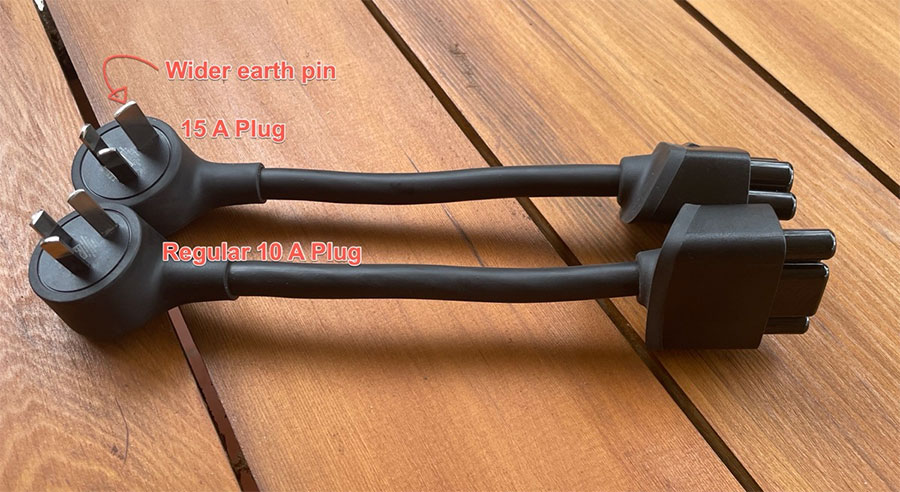
The 10A and 15A ‘tails’ from a Tesla mobile connector. The Tesla mobile connector is unique, as far as I know, in that you can buy a 32A tail, to charge at up to 7 kW from an industrial-style 32A socket.
The difference between a 10 amp and 15 amp outlet has little to do with the earth pin. The real distinction is that an electrician must design the wiring and circuit protection behind the wall for the rated load. The cable must be big enough to handle the heat and deliver enough energy to do the job.
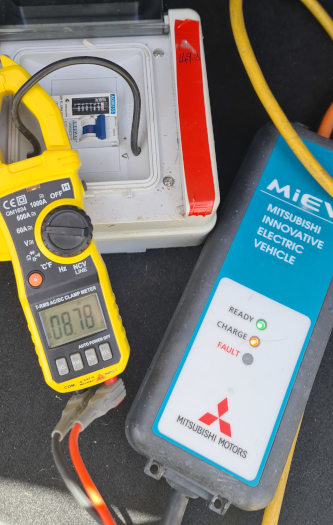
Checking the current draw, seems 8.8 amps is as much as it will pull.
My own PHEV came with 10 and 15 amp chargers, and I have measured them draw around 8 amps and 12 amps, which is 80% of the rated current available from the respective GPOs.
This thing is that they draw 80% of the rated load for hours on end.
Your kettle might draw a similar amount of power, but it doesn’t run for more than a couple of minutes. A bain marie or a compressor might draw a similar load, but cycle in and out.
Standard EV chargers just run full-time at full whack.
You Will Have Problems When The Plug & Socket Aren’t Perfectly Good.
For example, when you plug into a standard indoor type GPO that’s spent 40 years in a carport, there’s some chance it’s got some corrosion on the contacts. 20 minutes to vacuum the car will be no issue, but 8 amps for 6 hours, otherwise expressed as 2kW to charge 16kWh into a PHEV battery, will likely melt the plug and socket. It’s a torture test that will soon find the weak links.
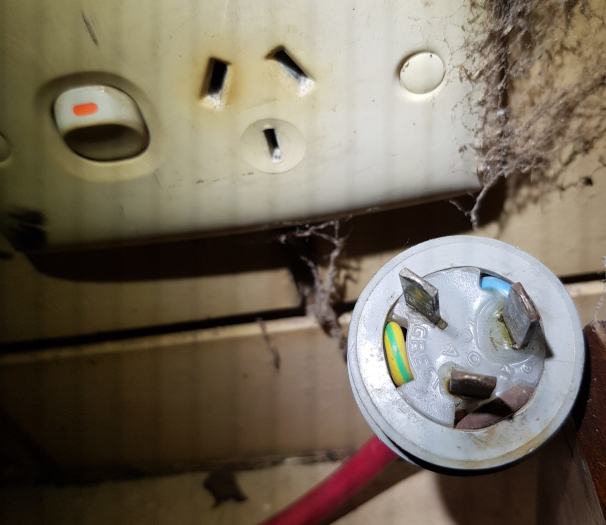
Notice the browning of the wall plate around the left-hand active pin, and the “puddle” of melted plastic around the opposite neutral pin on the plug. This is exactly why you must be vigilant when charging an EV.
The same thing applies to the extension cord you inherited from Dad; the one he might have naughtily made up to plug the 15 amp caravan into a standard 10 amp GPO. It doesn’t have to be dripping in verdigris, but if it isn’t perfectly bright and shiny there’s a good chance you’ll generate some heat that will damage the plug and socket.
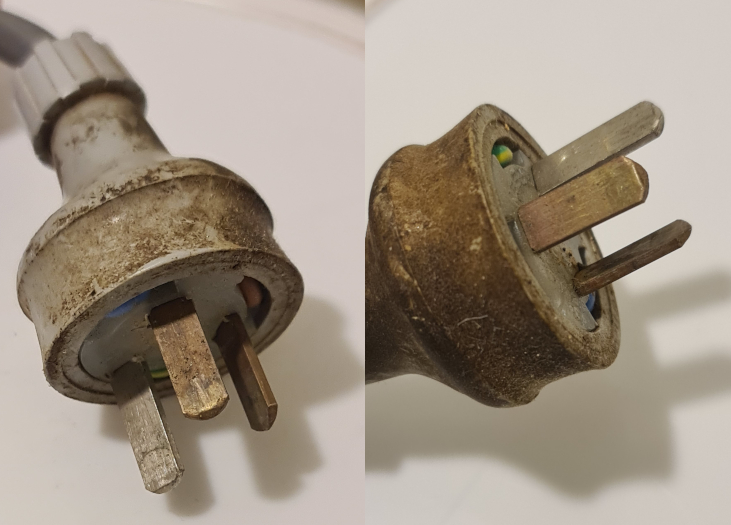
At the very least, this pre-2004 plug must have the pins scuffed, sanded or polished until you have 10mm of shiny bright brass. It will likely cause trouble otherwise.
Always Switch Off The Powerpoint Before Disconnecting
Whenever you use a plug-in car charger, you should turn the switch off at the wall before unplugging the cord. No, really; this isn’t nanny-state hyperbole this time. If the plug or socket has been damaged, the pins may be welded together. Whether it’s still hot or not, the plastic could be melted enough that the plug comes apart in your hand, exposing live metal parts.
So far, I’ve had to replace one plug top, two cord extension sockets and 2 GPO wall plates over five years of charging a car with a standard EVSE. None of them has been what I would call a dangerous situation. I’ve just noticed the plugs were hot to the touch, the plastic was soft and, as a result, discoloured or slightly deformed.
Thermal images show a plug & socket assembly in the middle of this experiment is running comparatively warm.
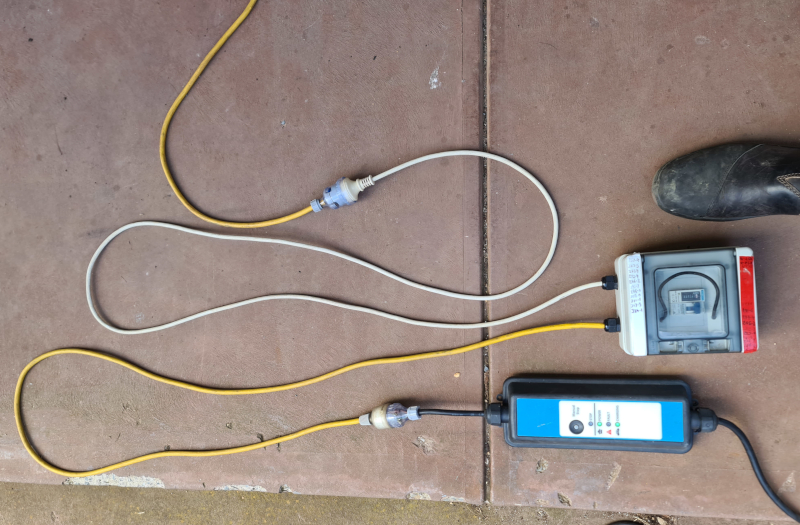
This experiment involves a supply from the top and human foot for temperature reference. The random recycled white appliance lead connects to a breakout box with a kilowatt-hour counter and loop for measuring current. Then the Mitsubishi supplied EVSE at the bottom is connected to the car itself.
Everything Is Rated For A Perfect World, But…
- Household wiring normally uses 2.5mm² cable behind the general power outlet back to the switchboard.
- The so-called “heavy duty” extension cords you buy from Hammerbarn are only 1.5mm².
- Standard household extension cords are as little as 0.75mm².
- These skinny (or excessively long) cords create loss and may overheat if coiled up.
- The losses mount up, especially if you have a shed out the back that was wired for a single GPO piggybacked off the house.
What Else Should You Look Out For?
Be aware that things like powered sites in caravan parks are normally held in contempt by electricians. They’re often poorly maintained and can offer marginal capacity. I have seen first-hand examples that meet the stereotype. They’re old, cruddy and not well-designed in the first place. With the rise of all-electric camping, there will have to be improvements made.
Ironically, PHEVs are quite popular in towing caravans across the UK, and I must relate an amusing story.
In England, etiquette, like queuing, is a finely developed art. So it seems the poms have decided it’s bad form to “pump fuel” out of the caravan park into your car, so they plug the van into the mains riser with a cord, then run a second cord out of the van to charge the car. Apparently, the physics of adding a dozen connections, potential points of failure, or maybe an electrical fire isn’t as important as saving face in a budget holiday park. People are ludicrous.
EV Charging For Renters
- If you plan to use an extension cord, the best approach is to get an electrician to make one. That way, you have new contacts and a cord that’s just the length you need using 2.5mm² cable.
- While you’re at it, have them install a new, good-quality wall plate for the GPO you intend to use.
- Apply a small amount of preservative to the plug, such as Inox or the heavier Lanox to prevent corrosion.
- It should go without saying that double adaptors and power boards should not be used at all.
Regular Powerpoint Charging Is Best With A Dedicated Circuit.
If you intend to use your standard plug-in EV charger regularly, then it’s worthwhile having a proper circuit run from your switchboard with an industrial-style IP-rated plug and GPO. These are weatherproof, so they can be installed outdoors, but I still wouldn’t recommend anything electrical be installed in the driving rain or blazing sun.
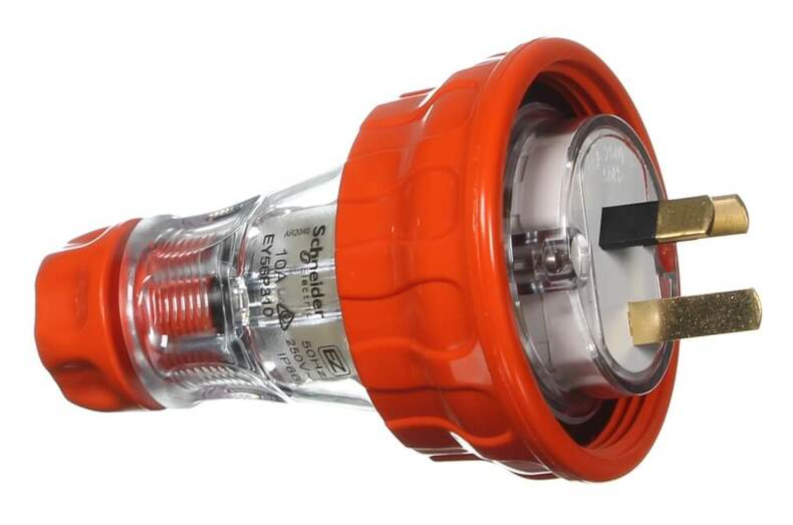
Not only is this plug sealed with an “O” ring to make it weatherproof to IP66, the screw collar means it can’t be withdrawn inadvertently.
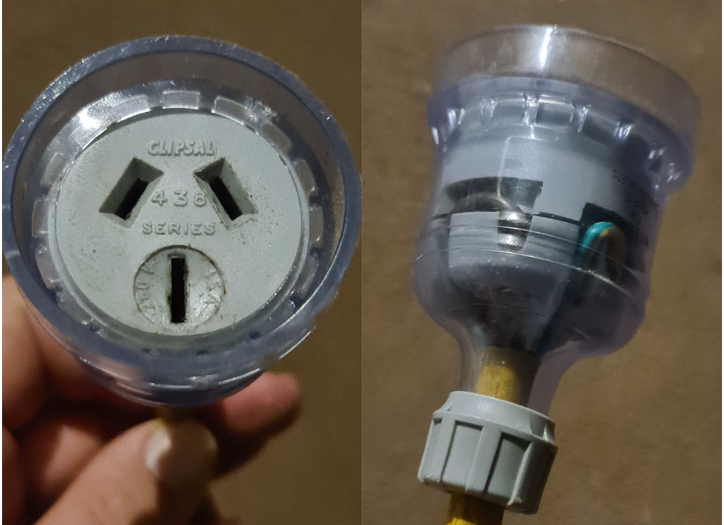
If you install a screwed connector to your EVSE/brick, it will still mate with a standard GPO or cord extension socket like this 15 amp one.
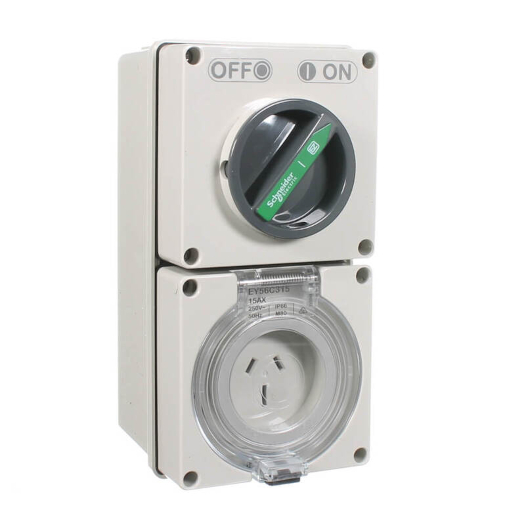
This is the matching 15 amp socket outlet for a screwed connector. They will still accept garden variety appliance leads but probably not a plug pack for your Christmas lights.
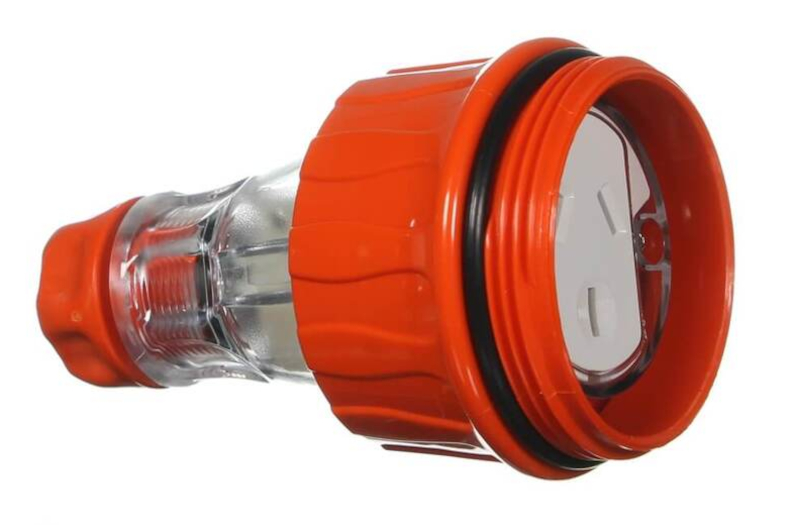
This socket is how extension cords are done right.
Run A Data Cable While You’re At It.
Running a Cat6 data cable or two alongside the new supply is also highly recommended. This allows a reliable hard-wired internet connection for a charger. As we progress there may be a call for DNSP control of EV charging, just like they already do with solar generation and air conditioning demand response to help maintain stability on stinking hot afternoons and mild spring days alike. An internet connected charger also opens up the possibility of charging coordinated with dynamic tariffs like Amber.
Solar Smart Charging With A Mobile Connector
If you are installing a dedicated circuit, you could get some basic solar-smart automation done at the same time. Using a solar diverter such as a CatchPower relay, it’s easy to control the EV circuit so it only uses excess solar energy generation or off-peak rates if you have TOU metering.
Bear in mind the cost of cable is negligible compared to the labour involved with crawling through the roof, so specify at least a 6mm² cable (in single or 3 phase if you have it). That allows a nominal 7 or 22kW charger to be added easily if the need arises.
Solar-Smart Charging Without Extra Hardware
If you only charge Tesla EVs and have a solar inverter on this list, you can do solar-smart charging with a dumb charger without paying for any extra hardware or wiring, via the ChargeHQ app. This is possible because the app can control charging by talking to the car, not the charger. I’m not aware of any other electric car brands that offer this.
We’re Dealing With Serious, Sustained Power Draw
At the end of the day, EVs will push the rated capacity of the wiring in your house, the connection to the street and the grid more broadly. That’s not to say we will overload everything and there will be mass blackouts and a war on the weekend. That would be useless dumb hyperbole, when in actual fact, EVs will help with the transition away from fossil fuels.
We need to remember that when you plug in a car, it will pull a significant amount of power from the wall. Until now, few commonly available appliances pull power as hard and fast as an EV. So, make sure everything is up to snuff or, if you don’t want to worry about it, bite the bullet and get a dedicated circuit and wall box charger.
Learn more about electric vehicle chargers in SQ’s EV Charging 101 guide.

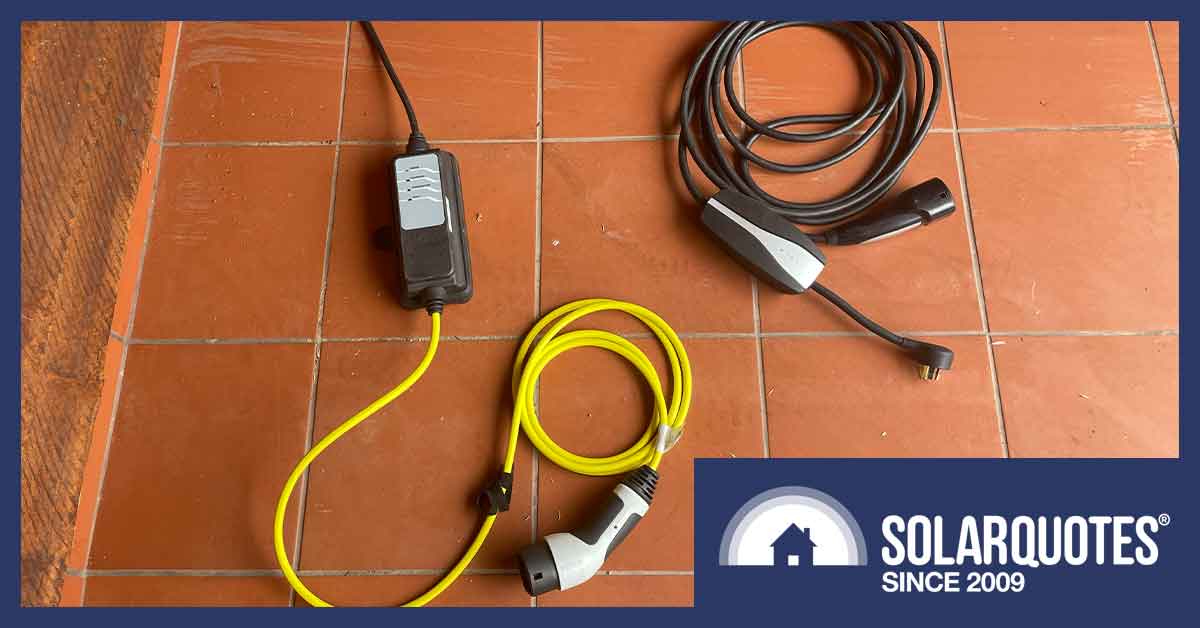
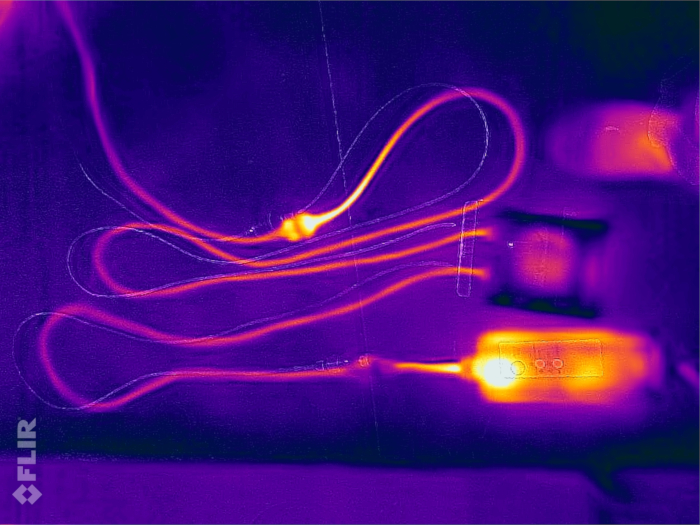
 RSS - Posts
RSS - Posts



I think a genuine tightarse would include instructions on how to re-charge your EV using the neighbour’s supply.
Funnily enough this was the original header image – until the post became all about home charging…
Anthony,
you did not mention loops in cables. I always ensure the cable is free of loops (to reduce Inductive heating).
Like you, I plugged in for years. I also replaced a few plugs & sockets.
I have a genuine 2.5 mm sq lead I bought from Masters some time ago. This definitely needs to be stretched out to use.
My economical wall charger is a ZJ Beny OCPP charger (wifi linked) that has a single phase 32A plug & socket. The main thing is any connections must be tight, & I like using ferrules to contain the wires.
My OCPP charger runs from Home Assistant, using the OCPP software module.
With a dumb charger, it would be possible to control the 240v with a wifi switch (Tasmoto or similar) controlling a min 25A contactor. This could easily be controlled by Home Assistant.
One other issue I see is really slow charging: Charging an EV at less than about 8A (ie 2Kw) is where the efficiency reduces. Unless the power is free, always charge at a rate where the efficiency is better than 90%+.
That’s great information Doug,
My comrade Michael is currently on the hunt for a zjbenny charger but the supply of them seems bit tight at the moment. He’s also keen to see what he can do with some OCPP smarts and I think I’ll get the pleasure of crawling through the ceiling space to install it.
I understand SAPN are running a trail using the same protocol. They offer the punters 30 cents per day to assume control of car chargers while they run the experiment.
Is your 32a outlet a round pin 3phase style or a flat pin with the channel shaped earth prong? I’ve seldom ever seen the latter out there in the wild but I do think there’s some wisdom in having car chargers that aren’t fixed to the wall. Plugs make them more user serviceable.
Thanks again for the constructive comments, much appreciated.
We have a 32amp industrial power point and 32 amp tail for our tedsla mdl3 lr charges overnight at off-peak rates I am curious why the app shows a 45 amp rate at times is this a glitch with the app or is the 45 amp rate possible
That’s interesting. The Tesla mobile connector is single phase and rated at 32A maximum. 45 amps should not be possible.
What does the screen on the car say?
How many kW of load does the Tesla app say your home is pulling overnight?
This happened to me once over a year ago and the car was pulling too much current through the circuit. It popped the breaker. There are three 16A chargers in a Model 3/Y and only 2 should be used on a single phase supply which draws 32A. I think there was a software glitch and the car kicked in the third charger. It only ever happened once.
Looping an extension lead will not create inductive heating. This is a misnomer. As both line and return (active and neutral) are in the same cable, they cancel out any induction. However, there is an issue with confining all the heat generated in the cable to a small space which can itself lead to problems.
If they’re taking me for $30, just to park for a few hours, I’m taking $1.75 home with me…
On the subject of Charging I am wondering how the approved wall box bi-directional charger works from a protection and earthing point of view. I am told that for anything that is connected to a household you must have a M.E.N in place. Is that the case for the bi-directional EV charger. I have an EV with VTL ability and have has an REC install a designated generator circuit with a Manuel change over switch and a CB of 15Amps. When I connect a small generator this works fine as a limited supply for my house. But not when I try to discharge from the car. From testing we believe the issue is the M.E.N and the fact the EV has a sensitive 15milliamp RCD that sees this MEN. Given the change over switch only disconnects the active and is not double pole (Disconnected active and neutral) we believe this is the issue. But a double pole is not allowed. How does the bi-directional charger get around this issue?
Hi Ross,
You pose an interesting question and I might have to dig up an image from standards to answer it fully, but this is an issue we encounter with off grid systems using generators.
Depending on the model, gennys are now supplied with their own MEN connection and we need to disconnect and label them when we hard wire the generator to an installation. While the alternator winding supplies current to the installation, the installation supplies the earth to the generator so to speak.
Your little camping generator doesn’t have an MEN and in fact many like the Honda 2i can be thought of as just an isolated coil, the earth pin in the socket is only connected to the screw terminal on the plastic case of the machine.
As for the bi-directional charger, I will pose that question to Jetcharge for a full explanation but I suspect there’s some vagaries involved with the charger treating your car simply as a battery furnishing DC to/from the wallbox.
Whereas the V2L function from an EV relies on an onboard inverter that furnishes 240VAC just like a generator.
Thanks for the insight and I’ll try to get back to you soon.
lol.
I’m still curious how (logistically) service stations for petrol and diesel aren’t constantly queued around the block, with an average of 2900 vehicles at last count for every station in the country. And with no regulated re-fuelling procedure, everybody just turns up when they need to. Something in the way that was figured out should be applicable for new fast-charging stations for EVs. We should need fewer of them (there are 7000 traditional service stations), as most daily use can be charged at home, whereas everybody needs to go to a servo to get petrol or diesel. And I read there are already 3000 fast-charging stations in Australia.
Hi Nick.
Interesting observation. I don’t have a link to hand but I think cars spend 95% of their time parked so there’s not much time to spare if you want to clog up a servo with one, although it seems coffee is the main reason for servo congestion now…
And not everyone stops for fuel every day, much like EVs don’t need to be charged every day either.
However what we are really going to need is infrastructure to plug cars in during the day, absolutely where ever they’re parked, to soak up solar. Then we don’t have a huge demand spike at 6pm when everyone lobs home.
just my comments;
Most vehicles are parked 23hrs a day.
Avg energy per vehicle is 7kWh daily. MPG converted to kWh.
The home robotic vacuum cleaner can teach the self parking EV to plug itself into the grid.
20million vehicles in Australia, if 100kWh batteries then 2,000 gWh would be available and dispatchable daily.
Fossil fuelled maximum generation is 600 gWh daily if you are lucky.
Every building, 20million in Australia, is connected to the national grid.
Every building has a rooftop. A free structural support for 20million 6.6kw of PV solar panels.
The huge benefit is that the national grid is UNLOADED by 50%.
Huge transmission costs are removed from future grid capacity expansion and construction costs that central power generation and distant renewable farms need.
Dispersing the central generated electricity is now not needed, and the existing grid is perfect to balance power in the grid.
The money will be in the grid connections, a permanent cash flow that does not need government guarantees.
Unlike nuclear generation that needs government disaster insurance,
and all other countries to have nuclear industries to free the atmosphere of CO2.
And increased uranium exports and increased military budgets,
And be locked into, soon to be ancient, nuclear power plants.
Nuclear to charge 20million EV energy storage, batteries.
The EV will be the national energy storage devise that does a little drive daily.
We need to know what is in our future and build the plan to get there.
20million 6.6kw roof tops is 660gWh daily for free.
We know that a rooftop system is cheaper than the windows in a house.
We know that the 33m2 rooftop system is smaller than the smallest 100m2 house.
Nobody talks about these practical facts.
All the dictators can steal this technology and save the planet.
Hahaha.
Steve.
20 million EVs will also require a recycling/disposal strategy to be implemented for the batteries as they fail. Perhaps a portion of the registration fee could be set aside to fund construction and ongoing costs for the facilities.
And of those 3,000 how many are working at any one time?
What’s the point of further expanding the public charging network if the network owners and charger suppliers can’t maintain a decent level of uptime with the existing numbers?
Telsa can do it, why can’t the likes of Evie and Chargefox. Don’t get me started on Tritium 🙁
Funnily enough, in the WHS meeting I was just in, we were looking at a photo of a car parked outside of one of the work buildings, connected via a long extension lead running through an open second floor window…. :-/
Brian we have to look for the positives, that sounds like an extension cord that’s not going to overheat 😛
Hypothetically, if one had an inverter/battery capable of drawing 15amps and a CABLE rated for 15Amps but with a 10amp PLUG, what would be the likely outcome, assuming it didn’t blow a fuse in the switchboard?
Rod it might blow a fuse in the switchboard…
However there’s a chance that it will be fine. Standard GPOs are a nominal 10amp but the circuit protection is a 16amp breaker, which allows for a few appliances to run on a single circuit.
The surge rating and indeed the tolerance of the breaker also means it can carry up to 1.8 times the nominal current for up to 500 seconds. ie you can run two kettles, perhaps even three for a little while.
What brings things undone is heat. If you consistently run a large load through a circuit breaker it will get warm and the current rating is determined by a bi-metal strip which responds to heat. So a long slow overload may last for hours whereas a dead short circuit causes a massive current that throws a breaker open magnetically. ie switching on the fourth kettle just trips the circuit immediately.
The risk involved with putting a 15a load on a 10a nominal circuit is that the cable in the wall may not be rated for the load. Most wiring is PVC, rated for 75°C and there are de-rating factors applied depending on if the cable is run in air, clipped to a surface, bundled with other cables, in a hot roof space, inside a conduit, in the cool earth, in the radiant sunshine or surrounded by bulk fill insulation.
And the other major concern is voltage drop, which is all about distance. When I plug into my Dad’s shed and draw 8amps across a 60 metre route it’s probably running 3.4% loss, which is really marginal. Upping that to 15amp means 6.4% loss and a pretty doughy 215 volts at the power point. It’s well beyond the rules and may damage your EVSE if it will even work.
It’s about weather you’re going to cook the cables from the inside out, or the outside in… or both, and it’s an electrician who gets to decide what is appropriate in terms of circuit design.
Thanks for taking the time to write this excellent explanation Anthony
I am convinced not to hypothetically try this now
Hi,
If the cable is not suitable for use with a 16A CB, then the person that installed it should have used a 10A breaker.
You can have a lot 10A GPOs on one circuit (10-15-20?? – I did read it somewhere), all protected with one 16A CB.
FWIW, I have disassembled both a 10A & a 15A Clipsal single GPO, and found they have the same internals, interchangeable parts, etc. Only the Earth pin slot was different. The moulding was the larger size, must have a machine the cuts it one size or the other. I checked them recently because I was interested to know if there was any physical reason for not allowing mismatched plug/socket on one lead.
b0b
I am an electrician and for the reason that 10 and 15 amp plug tops are often melted, I installed a 20 amp gpo instead of a 15 amp one. Same size 20amp MCBO protection. A 20amp australian plug top , with larger thicker pins then stuck on the nominal 16amp charger …actually pulls 14amps … without any sign of heat at the plug. You can still plug a 10amp plug into it if needed for a vaccuum or something but I have cordless for those rare occassions. Cheers
For 3-phase I would say go even heavier on the wire – 6mm2 on 3phase partially surrounded in insulation is only good for 30A, and that’s right at the thermal limits too. Even 6mm2 on single phase is only good for 35A, but that’s assuming the roof space is 40 deg C, it can get way hotter than that if there’s no anticon.
Matt,
even on my short run single phase 32A (Industrial) Socket I used 10mm cable. Considering we will be charging cars for years into the future, the extra cost of larger cable & making sure the cooling of the supply cable is considered, the extra cost over the life is really miniscule.
I am building a secondary dwelling on my rural property. It is 70M from the main house & I have a drum of 16mm cable, so that is the (underground) submain size. I will get around the voltage drop by installing a battery to cope with peak demand. The EV will be charged by excess PV only (at the new house) & if a fast charge is required, I will use the EVSE at the farm shed (on 35mm sq mains).
Anyway, the reason for talking about this installation is that on any charger install, all the voltage drops (= loss of efficiency) must be considered. It is also not worth charging an EV from a home battery due to the losses. That also can shorten home battery life.
So like a car, where we look at the Total cost of ownership (TCO), with our charger we also need to consider all costs, efficiencies & losses, I think this is where a Management program like Home Assistant can help. HA allows (once set up!) an overview of all the smart devices in a home, including an OCPP EV charger (or any smart charger that allows external control).
You’re right Matt,
Rules of thumb abound but 6mm² is really the minimum you want.
I find it ludicrous that Australians build houses without insulation under the roof cladding. They kind of make this cardboard house with some fluff around it, then put it all under a shed roof, then expect the ducted air conditioning (which is outside in the shed) to cope with keeping things hot or cold.
Anthony,
Would a Catchpower Relay diverter really do for an EV charger? I’ve just finished reading that they don’t like the “hard reset” of power interruption. Some time ago I also read that charging will not necessarily resume when it is reconnected. (Lack of relevant knowledge does amplify disquiet.)
Off-grid, I’m trying to find a solution which only diverts excess PV, in a proportional manner. The Victron smart charger can be inhibited below a set SOC on the home battery, but that’s far from optimal. (The 20 kWp arrays may be limited to putting < 10 kW into the house battery, if it'll take that much, but if it's only half charged,, there's possibly 10 kW looking for a home, and a blind dumb charger pretending to be smart.) I've found a hack for Victron's open source VenusOS firmware on their GX controller, doing what's needed, using either a go-eCharger or an OpenEVSE one. (Scroll down this page for a brief description:
https://github.com/gabriel-samfira/solar-ev-charger )
While that could be a lot of fun, something an electrician could just install, configure with some smartphone clicks, and we're good, would be just dandy. (Life's too short to reinvent every wheel – or even hand carve a copy.)
Anyway, if you bump into a genuinely smart domestic EV charger, not reliant on a Current Transformer on a grid tie, then I reckon you have the makings of a very fine follow-up to this practical intro to the care and feeding of EVs.
Given how long it took to get isolators off roofs, why should this one be quick?
Thanks Erik,
My little EVSE doesn’t seem to be affected by running from a time switch but it’s probably better if we don’t interrupt it often. I have forwarded your Victron hacking to the best bloke I know with an interest and will show another dedicated off grid technician tomorrow, so thank you. I might also punish Scott from catchpower and see what they have in the pipeline, beyond a 3 phase unit which I’m assured is coming.
cheers
Hi Anthony,
The message that some EVs might not restart charging if power feed is interrupted might be (at least partially) just caution. But on page 51 of Fronius_Wattpilot_Operating_instructions.pdf , I read: “Minimum current: Some cars will not resume charging after an interruption.
To prevent an interruption, the minimum charging current can be set.”
I’d tend to favour a charger with the feature, as I have no idea how a Radar RD6 might behave, or if that’s what I end up with once there’s a bit more choice here.
(Incidentally, I may have improved the name of that file after download, because another quick google comes up with one called 42,0426,0435,EN.pdf , and it’s a different version.(Same caution, but on page 53))
Many thanks for taking an interest in the next-level energy management gymnastics which some on-gridders would like for minimal energy bills, and off-gridders need if they’re not to fire up a dirty great CO2 belching diesel to charge the putatively clean green EV, only to have the clouds move on later, making the unwholesome emissions wholly unnecessary. (Plundering the house battery isn’t a useful option, except for brief cloud fill, I figure.)
Prioritising a Wattpilot & an Ohmpilot (EVSE & HWS) seems to require some obscure setting incantations, which reduces my confidence in being able to gain the desired level of control. The Victron smart EVSE talks to one of their little GX controllers, and if the default capabilities don’t last the distance, the option of diving into the VenusOS software offers a way forward. (Even if it’s just downloading a newer software version from the manufacturer, via LAN or flash card.)
I suspect the statement “The so-called “heavy duty” extension cords you buy from Hammerbarn are only 1.5mm².” might be a bit misleading. I suspect most “heavy duty” extension leads would only be 1.0mm². To get 1.5mm² I suspect mostly you would need to get an “Extra Heavy Duty” cord. In fact
Having just recently (03/2023) picked up a Tesla Model Y (P)
I can attest that they still do come with the 240V 10A/15A charger standard.
I had heard that these wouldn’t be provided but thankfully I hadn’t bought one in advance of taking delivery.
How would a 20 amp industrial socket work with a 15a cord? Could it maintain the full 15 amps from the EV charging lead better? In my case thinking of running a kiln off it too, and if that is the case it will also draw 15 amps for long periods of time. Also want to charge at a lesser rate than I generate.
Hi, do you know whether the new 2023 range of PHEV cars ie plug-in hybrid or EV with petrol engine sold with their own Type 2 branded charger only, CAN still be used with the old Type 1 charger?
I want to make use of the excess solar & MG, Mitsubishi etc say their Type 2 charger can’t be lowered from 7kw to the 3kw, it’ll just draw what it wants – I’d prefer a slow charge to not draw from the grid for 4hrs on a sunny day.
The car sales people can’t tell me if type 1 charging is possible at all, or supported. Do you know? Thanks
Level 1 charging is 110V AC and Level 2 is 240v charging. The distinction is really only relevant to the USA. We don’t have level 1 in Australia. Regarding the charge rate, the car will take whatever the AC EVSE (“charger”) tells it is available, up to to the cars maximum rate. So if you want to charge at 3.6kw on 240V you’ll need a 15 Amp EVSE. Or something solar aware could be worthwhile depending on the cost.
Really? I had no idea. The average house with solar panels have 5 or 6kW systems, as mine does. I recall seeing some tv story of someone definitely in Australia saying they don’t pay to charge their car by only charging slowly on a standard PowerPoint with excess PV when full sun, ie just putting their pitiful feed-in to better use. I recall seeing smart chargers advertised a year ago that adjusted the charge based on excess solar, so you don’t draw off the grid (when sunny using solar PV.).
You mean this could never be done in Australia?
I am not sure about Fraser comment about “Level” 1 chargers being only the US, but my understanding is a bit different. But I am not an expert in this and maybe there is some subtle difference he is refering to when he says “Level 1” vs Type 1 which I though is here to at least some extent.
But I can offer some insights into throttling charging speeds of the charging to match solar. To do this to great affect with a Tesla Model 3 and the once included “Mobile Connector” which is a plug into a regular 10A or 15A power point charger.
Broadly speaking there are 2 different potential spots where you can potentially throttle changing. 1) is a smart charger which allows you to do this, and 2) is the vehicle itself. Any particular EV or charger, might or might not have this capability. And depending on the EV or charger, you might be able to control these automatically or manually. You only need support in one of these 2 get the job done.
For option 1), examples, look at the Smappee EV chargers or Zappi EV chargers with the extra bits required to have them do the charge from solar only option. This appoach saves the car needing to have an smarts and also packages up the meters for the grid to enable this solution to only charge from excess solar.
I know that the Tesla model 3 allows you to control the charging speed via the vehicle (independant of the charger) either manually, or as I do automatically with tools like HomeAssistant (documented on another blog post here or in the HomeAssistant forums). Your mileage I suspect with this sort of thing with other vehicles will vary.
I use the inbuilt Tesla model 3 functionality along with HomeAssistant and a grid meter to automatically match charging speed to spare solar and this would really well, and 95% plus of my approx 600km / week to come from solar. I also have an adjustable threshold I can set for km I need to charge to overnight in off peak times, so it is mostly plug in and set and forget.
Yeh, for me it’s about the car salesman not having a clue & only wanting to sell their brand of charger that only charges at 7kw, (instead of the lower 3kw I want to maximise full sun & not pay electricity bills where I don’t need to.) If any other type of charger is not supported I’m assuming I’ll void the new car warranty. Then I’ll just buy a petrol car as it’s a deal breaker for me.
I would be almost sure you won’t have any issue getting something setup that will limit charging at lower rates than 7kW if you want. I suspect all EV and PHEV will have some sort of option to charge from regular 10A or 15A power point, or they will be leaving themselves without the ability to charge from the easiest and most widely available charging source. Most common 10A household socket chargers will be limited to 10A / 2.3kW. 15A plug would be 3.5kW give or take. Quick google of MG and Mitsubishi reveal they appear to have these options and looks like they come with the vehicle. So probably a case of crap sales person rather than missing capability. If you want faster charging, I suspect that will be the need buy and additional charger. But I am almost sure no vendor would lock you into only their charger. And you could probably by practically anyone’s charger, with the right cord to suit your vehicle plug and you are good to go.
As for “not supported charger voiding the warranty”, that sounds like complete rubbish. It is just about making sure you have the right plugs for your car. But even then, you can probably buy adaptors to go from one type of plug type to the other. I suspect MG and Mitsubishi will come with what you want (cable to plug into standard power point and charge slowly). But if u need other combinations or permutations google people selling chargers, or look up or speak to someone like evse.com.au and no doubt they will set you straight. I doubt any manufacturer would be stupid enough to demand you only charge from their own brand charger as that would be them shooting themselves in the foot.
But getting a slow dumb charger is not probably the best way to charge if you only want to charge from solar only. While it might only charge at a lower rate and be often keep you solar below the generation threshold, it is missing components needed if you only want to charge from solar. eg what happens when a cloud comes over, or it is overcast, or you have big household loads. Conversely with your 6kW solar at peak output and low household loads, you probably want it to charge at more than 2.3kW or 3.5kW which these chargers can’t do.
I more feature rich solution if solar charging more of the time is to get a 7kW or 22kW Zappi or Smappee (or probably others) that will enable you to more accurately charge from only solar. These solutions will all have some sort of monitor on your grid connection, and ramp charging up and down based on grid import/export. These might cost you a couple of grand. But they will do what you want. And I would be almost positive there will be no issues with anyone’s warranty.
Sorry, couldn’t reply to your most recent post
“If any other type of charger is not supported I’m assuming I’ll void the new car warranty. ”
Is that really what the salesman is saying? What brand of car is it – I’d check with the manufacturer.
Thanks everyone for your replies, appreciate it. It’s too hard. I’ve just gone & bought a petrol car, dumb ha – can’t wait a year for an EV or PHEV anyway. It’s tricky enough to organise local garage to service a new car – with genuine branded oil & filters, to not risk voiding dealer warranty – let alone risking using an after market ‘not dealer supplied’ charger too.
The sad truth with maximising solar, Sydney has had 3 unseasonably wet & overcast summers in a row. My wifi’s too crap & inverter offline so can’t connect to check currently unless I climb a ladder but I’d say max PV on typical overcast middle of day is about 1.5kW. Back in the unseasonably sunny winters of 2018,-19, we had the opposite, oodles of PV, hot summers (bushfires) etc, the inverter was on the blink then & not working at all (swapped under warranty but too late to take fraudulent solar installer to NCAT & claim back paid electricity bill.) I know most solar installers are not fraudulent, my 86yo Dad got conned.
And I’ll have to install PowerPoints & plug-in a wifi extender to stop the inverter wifi dongle from going offline all the time, to just make sure the damn inverter’s still working
I was going to go on ABC’s 7.30 ‘Dark side of solar’ story after years of trying to figure out who installed what, badly, on my Dad’s house.
Still trying to find a trustworthy electrician willing to work on an old house – in Sutherland shire Sydney – know how to find one??
There are various EV charger offerings claiming to only use excess PV generation. I’ve just stumbled across an SMA unit. For a nifty real world dynamic energy shuffling plot, pause at 3 minutes in https://www.youtube.com/watch?v=MUReCuaN0hU to skip all the waffle. (In German anyway.) The outer light yellow is PV generation, the blue is EV charging (Look at it track), the darker yellow along the bottom is battery discharge, and the red is network intake.
The dynamic energy management looks very good to me. It’s mostly (maybe always) using only excess PV, as there’s minimal battery discharge. He doesn’t give a model name or number for the SMA smart charger, and who knows if it’s available here? About the only interesting thing he says in 9 minutes is that he loses 24% of available PV generation because he only has a 16A 230V single phase circuit for the charger, and that 3.6 kW won’t always take all that’s available.
He sings Finn’s song when he says “Mach die Däche voll.” (Make the roofs full.) He just shouldn’t be surprised when you can’t use it all on a particularly sunny day. Having to look for more loads to hang off the system seems to be a definite first world problem.
It is my suspicion that the sales folk just don’t yet understand this feature or the growing market demand for it.
Hi Sharon,
If you enter your details with Solar Quotes we can source a reputable solar installer who can diagnose & rectify your Dad’s place.
As for having a “compatible” charger, it sounds like the salesman insists you use a particular brand of petrol pump… which like just like insisting on dealer servicing, is illegal under the trade practices act as far as I’m aware.
IEC standards dictate that chargers are compatible so that you can pull up and use public charging points in any brand of car.
Earlier Mitsubishi PHEVs had a “type 1” plug, which is a misnomer, it’s technically a J-1772 plug, but in Australia we need to differentiate them from Type 2 plugs which are becoming a much more common connection.
There certainly are options available for harvesting solar for your car and the other commenters here have done a good job of covering that.
You might also find some answers here :
https://www.solarquotes.com.au/blog/ev-charging-power-outlet/
My interpretation of Level 1 charging is that it is using a normal power point, Level 2 is using EVSE.
Are you sure you’re not confusing this with Type 1 vs Type 2 AC sockets, where the US uses Type 1 and Australia (and most of the rest of the world) uses Type 2?
Fraser is correct. Charging Levels are defined in SAE J1772 and are based on the North American electricity system topology with split-phase 120/240V LV supply. Note that Level 2 is not necessarily hard wired.
In the Australian context with a European style 230/400V 4-wire system IEC 61851-1 is a more applicable standard which defines 4 Modes and 3 Cases for different charging arrangements. Mode 2 charging is via a portable AC EVSE whether fed from a 10A GPO or an industrial 32A 3-phase outlet. Mode 3 charging is via a hard wired AC EVSE up to 63A. Note that anything that supplies electricity to an EV from an installation is an EVSE including portable E-bike chargers.
https://en.wikipedia.org/wiki/Charging_station
Anyone is of course welcome to define their own terms, but as defined in SAE J1772, Level 1 is essentially non-existent in Australia.
Great article highlighting some of the issues we are going to see once EVs become more prevalent amongst the masses.
I can’t help thinking EVs are going to really stretch the grid and domestic wiring. The comment on the 6mm2 was good. I caught an electrician once skimping on this and I pulled him up…he knew he had been caught out! But how many houses will only have the smaller size 2.5mm2 everywhere?
Thanks – keep them coming 🙂
You recomend installing a data cable along side the power to the charger. Where should the data cable terminate at the other end? Does in just need to be connected to my main data network? Or does it need to run to the meter box or solar inverter?
Having just been browsing the zappi manual last night… My guess is just in to your data network.
The zappi can use this if you want to link between multiple zappi (or other myenergi) units. No doubt this also means it’s less likely to suffer from Wifi issues also.
This is an interesting article. We are purchasing an off the plan apartment and the only aspect we could negotiate was a double powerpoint to be installed at our parking space. What type of powerpoint should we ask for? Is it worth it to install?
Hi John, at very least you want a 15a power point. If they baulk at that then push the point that the wall plate is a negligible expense and they may not even have to increase the cable size over a standard 10a power point, depending on the distance to the sub board or main switchboard.
If you have 3 phase power available then I would tell them you need a 3 phase 32amp outlet. Again if they baulk you can tell them that they’d better get used to it because EVs are a thing and they need to be across the trend. However you may need to volunteer some funds for more copper in the cable (ie at worst 4 strands of 10mm² instead of 2 strands of 2.5mm²) and an industrial type wall outlet.
This is a great and really practical article. Suggestion to run cable for both internet and for 7kW fast charger, even if you are only going to put in a 15A socket now, is such a good idea. Makes it much easier to upgrade if/when needed. Thank you.
We have 3 phase power and have installed an outdoor 3 phase powerpoint in the driveway on a dedicated circuit. We use this portable 3 phase charger to charge our EV: KWIK Portable Type 2 Charger | 32 Amp | 22kW.
It’s excellent, costs less than a wall charger and our 70kw EV battery charges at 11kw from 20% to 90% within 5 hours. We can also take the charger with us and use it wherever there is a 3 phase outlet.
Is there a smart timer you would recommend for using with a 10amp slow charger? I want to make use of the ev energy plans that have a cheaper window through the night.
Hi Luke,
I don’t have a got to option for timers but it depends how smart you want to get.
At the basic end there are mechanical plug in timers, really straightforward but not long lived because they’re so cheap these days. I’ve used a few of but having a simple override switch so you can turn it on without unplugging is a must.
Plug in digital timers can have a lot more options, like different times of day for different days of the week. Plus they hold time in a blackout.
Beyond that there are devices from Shelley, Arlec & various others which have varying degrees of smarts you access via an app.
For really smart management Home Assistant is a great way to automate everything in the house without having to resort to Google or Amazon.
Yeah, I’m familiar with those, just wanted to make sure I get something that’s safe to use with a ev charger. I’m only ever using trickle down at 3.6kw. Are those domestic one up to it?
Hi Anthony, I was wondering whether you have a company or do EV charger installations in Adelaide? I got some quotes from solar quote’s recommended places for ev chargers and it was somewhat expensive so I was thinking about getting a private sparky with experience in this area and purchasing my own equipment through manufacturer. Thanks John
Hi John,
You’ll probably want a 10mm2 cable and a 40a circuit breaker, but search the FAQs for more advice. I’d fit a 32a socket outlet and Fronius Wattpilot myself.